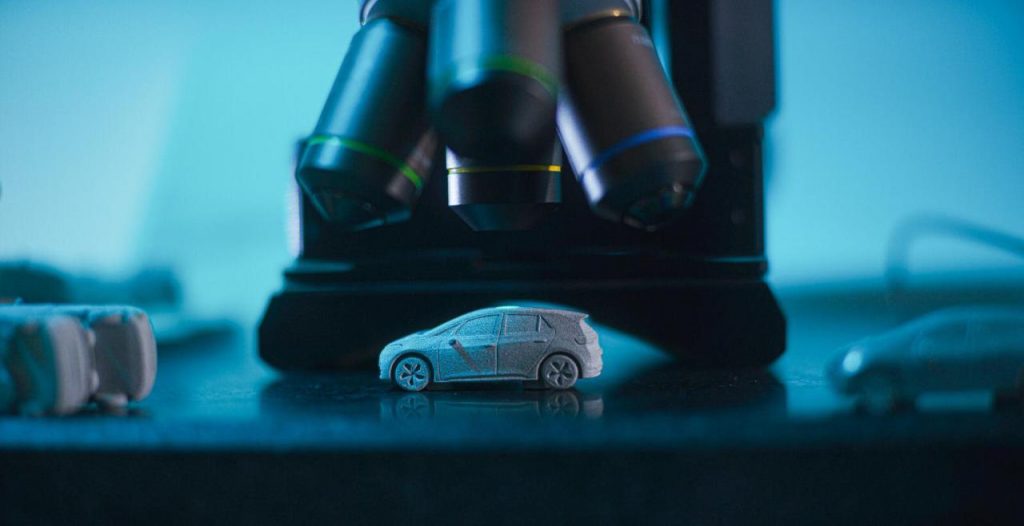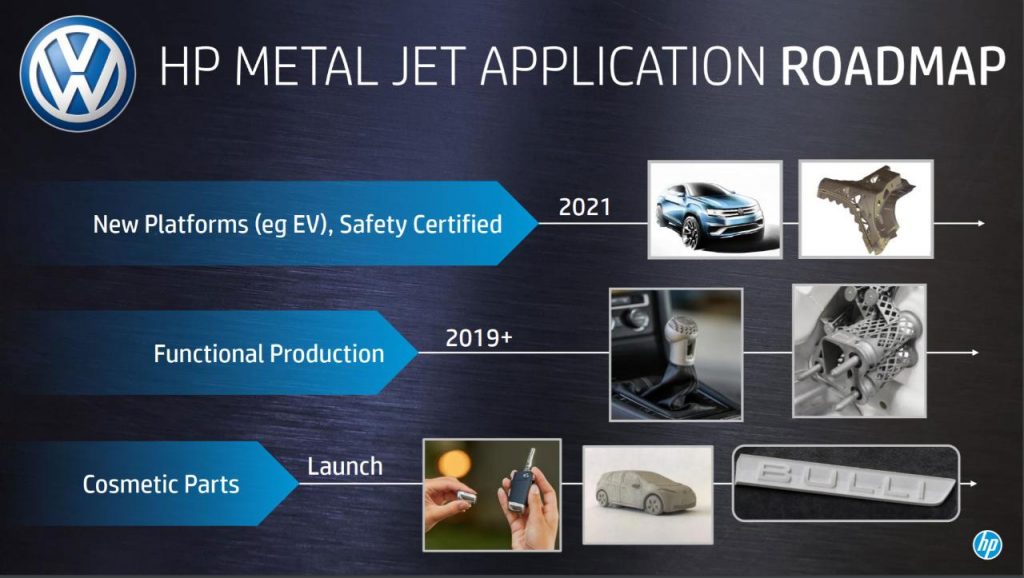Volkswagen has reiterated its commitment to metal 3D printing for the automotive sector with an announcement that together with GKN and HP, 10,000 metal parts were produced on the HP Metal Jet System.
The HP Metal Jet 3D printing system was used to produce miniature models of the new ID.3 electric vehicle for marketing purposes.

The €30,000 ID.3 entered series production on November 4th 2019. Germany’s Federal Chancellor Angela Merkel watched the first vehicle roll of the assembly line at the Zwickau plant in Central Germany. Once fully operational in 2021 the $1.33 billion plant will produce 330,000 electric vehicles every year as part of Volkswagen’s “global electric offensive.” The company states the Zwickau factory will be the “largest and most efficient electric car plant in Europe.”
To date, Volkswagen has incurred fines of $49 billion for the 2015 emissions scandal (aka dieselgate) and will be hoping that plants such as Zwickau and its electric offensive will go some way to atoning for that activity.
VW Group anticipates annual sales of 22 million electric vehicles by 2028 and CEO Herbert Diess says the company will be “climate-neutral by 2050.”

A three-phase strategic roadmap
While the parts made on the Metal Jet may not initially seem significant, HP is keen to emphasize that this is an important milestone marking the first step of a three-phase strategic roadmap.
Use of HP’s metal 3D printing at Volkwagen will begin with mass customization and cosmetic parts with plans to “integrate Metal Jet printed structural parts into the next generation of vehicles as quickly as possible and are targeting a continuous increase in part size and technical requirements.” The stated future objective is “soccer-size parts of 50.000 to 100.000 per year.” These 3D printed components are likely to include gearshift knobs and mirror mounts. Additive manufacturing will be deployed in the growing EV sector for the advantages it confers in lightweighting, and HP expects the production of “fully safety-certified metal parts” in the future.
Dr. Martin Goede, Head of Technology Planning and Development, Volkswagen said, “Our vision to industrialize additive manufacturing is quickly becoming a reality with HP Metal Jet, it is a game changer for the automotive industry. The pace of innovation by HP and advanced capabiltiies of the technology have exceeded our expectations. We are meeting our milestones and are actively identifying and developing functional parts for production.”
Tim Weber, Global Head of Metals, HP 3D Printing and Digital Manufacturing said, “A digital transformation in the auto industry is underway and Volkswagen is leading the way with strategic vision and bold action. We are committed to delivering the capabilities our customers need to accelerate the design and production of high quality final parts with breakthrough economics. Together with Volkswagen and partners like GKN we are standing up the factories of the future.”
HP Metal Jet will not available to a wider user base until 2021, but early access partner Volkwagen is satisfied with what they have seen. “We are extremely pleased with the technical features and the speed, quality and low-cost per part that HP Metal Jet has provided. The surface quality and feature resolution enabled great attention to detail and made it possible to add a special touch to this important company milestone,” said Dr. Goede.

Putting the brakes on?
Initial murmurs regarding the HP Metal Jet began in October 2017.
As we reported at the time the metal 3D printing process would be based upon metal injection molding (MIM) powders. One year later, HP confirmed that this would be the case and that HP Metal Jet pricing would be “under $399,000.” The lengthy gap between announcing the product and general availability in 2021 follows a similar strategy to the introduction of the company’s polymer-based Multi Jet Fusion systems. Observers have noted that such a strategy can be useful in freezing the market, leading to buyers to defer the immediate purchase of alternative 3D printing systems until they have a better understanding of the forthcoming machine.
Understandably, such tactics have generated some frustration in the 3D printing industry. However, an optimistic way to view the situation is that HP’s involvement in metal 3D printing will raise the overall profile of the technology. This may, in turn, benefit companies who are already active in the sector, or further along the development path.
For example, Digital Metal, ExOne, Desktop Metal, and start-up Trio Labs are just some of the 3D printing companies with MIM based technology. Other established additive manufacturing companies also continue to develop new metal 3D printing technology, for example, Stratasys Layered Powder Metallurgy.
With the year’s largest 3D printing event just weeks away, it is not unreasonable to expect the list of alternative technologies to grow.
The 3D Printing Industry will be heading to Frankfurt for Formnext 2019, so get in contact if you’d like to meet.
Subscribe to the 3D Printing Industry newsletter, like us on Facebook and follow us on Twitter for all the latest 3D bioprinting news.
Visit 3D Printing Jobs for new opportunities in additive manufacturing.
Featured image shows HP Metal Jet 3D printer at IMTS 2018. Photo by Michael Petch.
